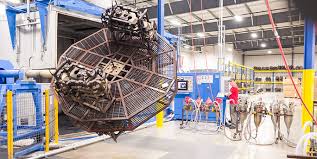Plastics rotomolding, also known as rotational moulding, can be described a versatile and cost-effective manufacturing process that produces hollow plastic components. This technique has become increasingly popular due to its capability to produce complex designs, durable products, and its suitability for both small and large-scale production runs. Here’s a complete overview of the essential information you need about plastics Rotomolding.
The Process:
Rotational Molding requires heating of a material made of plastic, usually in the form powder or granules, within an empty mold. The mold is then revolving around multiple axes. This allows the plastic to evenly coat the interior surface within the mold. As the mold cools the plastic begins to solidify, forming a hollow piece with an even wall thickness. The process typically involves several key stages: heating, rotating the mold, cooling and then demolding.
Materials Used:
The most popular materials used in rotomolding are polyethylene (PE) and polypropylene (PP) and nylon. Polyethylene is preferred due to its low price and high durability against impact, making it perfect for applications like tanks, containers and playground equipment. Polypropylene has a higher chemical resistance and is often used for industrial containers and automotive parts. Nylon is used for parts that require high quality and durability, such as gears and structural components.
Advantages:
Design Flexibility: Rotomolding can create complex shapes as well as huge, seamless parts that have no need for joints or seams. This design flexibility is perfect for creating custom as well as intricate design.
Durability: The process creates components with a uniform wall thickness and consistent mechanical properties, resulting in parts that are sturdy and durable. They also stand up to environmental and physical stress.
Cost-Effective: Rotomolding is generally more affordable than other manufacturing techniques specifically for large and medium-sized components. It requires comparatively lower tooling costs in comparison to techniques like blow molding or injection molding.
A low waste process is efficient in terms of the use of materials since excess materials is often recycled. Rotomolding is an environmentally sustainable option when compared to other manufacturing techniques that generate more waste.
Applications:
Rotomolding is employed in many different industries. In the automotive industry it is used to make parts like fuel tanks and bumpers. In the sector of consumer goods it is utilized for items like coolers, storage containers, and playground equipment. It is also used in the industrial sector for the production of bins, tanks and agricultural equipment.
Limitations:
Although it has its benefits, rotomolding does have limitations. It isn’t the best method for producing very tiny or intricate parts due to its relatively slow production cycle. Furthermore, it is challenging to achieve very tight tolerances or precise surface finishes compared to other techniques.
In the end Plastics rotomolding is a highly efficient manufacturing process that is flexible, durable and a cost-effectiveness. Its capacity to make large hollow pieces with uniform wall thickness makes it a popular option for a variety of industries.




